Supersets are a training technique where you perform two back-to-back exercises with little to no rest, keeping your heart rate and fat-burning potential up. These exercises often target different or opposing muscle groups, such as pairing a chest exercise with a back exercise. So if you’re looking to lose weight, boost your overall fitness, or a combination of the two, I have five of the best superset workouts for weight loss for you to check out.
The benefits of supersets are numerous. Firstly, they can help increase the intensity of your workouts, leading to greater muscle activation and potential gains in strength, size, and body composition. Supersets are also a time-efficient way to work out, as they allow you to accomplish more work in less time than traditional sets with rest intervals. Moreover, supersets can enhance cardiovascular fitness due to the continuous nature of the exercises, leading to improved overall conditioning and boosting your weight loss potential. Lastly, they can prevent boredom in your workout routine by adding variety and keeping things interesting.
Keep reading to check out a few of my favorite superset workouts for weight loss that I utilize with personal training clients and athletes. When time is of the essence, and there are goals to crush, supersets are one of the greatest tools you can have in your fitness arsenal.
1. Upper-body Superset
For an effective upper-body superset, pair an upper-body push exercise (such as bench press or shoulder press variations) with an upper-body pull (like rows, pull-ups, or lat pulldowns). To optimize your workout, I recommend matching vertical exercises with horizontal ones. For instance, pair a bench press variation with a bent-over row and vice versa for vertical presses and pulldowns. This thoughtful combination ensures balanced muscle engagement and maximizes your training efficiency.
Incline Dumbbell Bench Presses
The incline dumbbell bench press is a powerful exercise that targets and strengthens your upper chest, front delts, and triceps. Utilizing dumbbells heightens muscle activation, demanding stabilization with each rep. This exercise consistently delivers exceptional results, fostering upper-body strength and robust muscle growth with each session.
Sit on a slightly inclined bench, gripping a dumbbell in each hand at shoulder level with your palms facing forward. Keep your feet planted on the floor and your back firmly against the bench, engaging your core. Exhale as you push the dumbbells upward and extend your arms without locking your elbows, pausing briefly at the top. Inhale as you lower the dumbbells back down to shoulder level, maintaining control throughout. Complete three to four sets of eight to 15 reps of the exercise, then transition directly into the incline chest-supported row set.
Incline Chest-supported Rows
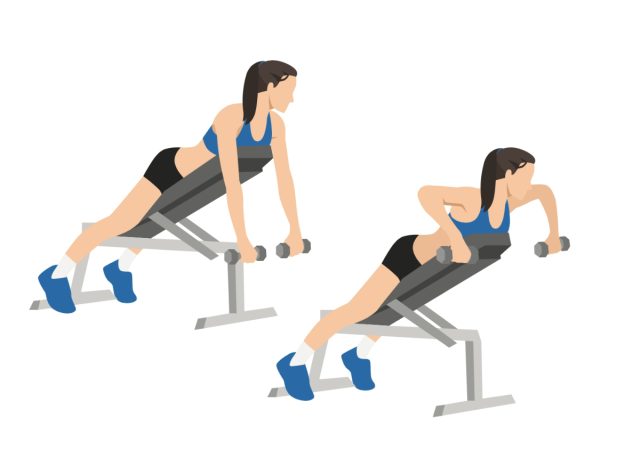
An incline chest-supported dumbbell row is an excellent exercise for targeting the upper back muscles, particularly the lats, rhomboids, and rear deltoids. By resting your chest on an incline bench, you stabilize your body and isolate the intended muscles, reducing the risk of momentum-driven cheating. This setup allows for a full range of motion and optimal muscle engagement, promoting better posture, strength, and muscular balance in the upper body.
Position yourself face down on an incline bench. With a dumbbell in each hand and palms facing inward, pull the weights toward your ribcage while keeping your chest firmly against the bench and exhaling. Focus on squeezing your shoulder blades together at the top of the movement, then inhale as you lower the dumbbells back down in a controlled manner. Complete three to four sets of eight to 15 reps with 90 seconds of rest between supersets.
2. Lower-body Superset
Get ready for a lower-body superset that packs a punch! This dynamic duo pairs a hip hinge exercise targeting your glutes and hamstrings with a lower-body push exercise that activates your quads. Combining these movements will maximize muscle engagement and sculpt your lower body from every angle.
Dumbbell Hip Thrusts
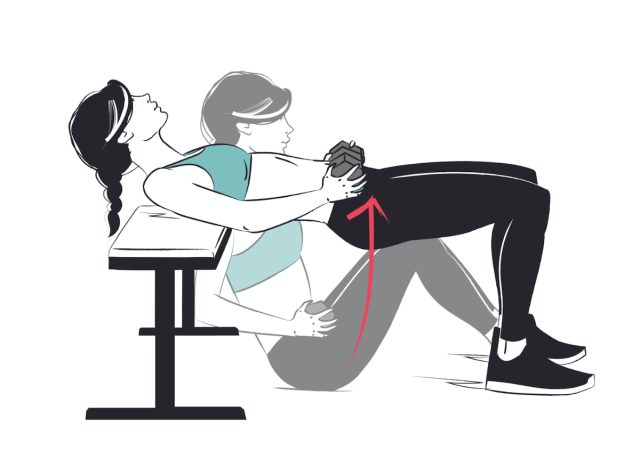
The dumbbell hip thrust primarily targets your glutes and lower back, with the hamstrings contributing to positional strength. It stands out as one of the top exercises alongside glute bridges for enhancing muscle size and strength in your hips. Incorporating this move into your routine can lead to significant gains in power and definition in this crucial muscle group.
Position yourself on the floor with your upper back against a bench and a dumbbell resting on your hips. Bend your knees, and firmly plant your feet on the ground, keeping them hip-width apart. Drive through your heels to push your hips up until your body forms a straight line from your knees to your shoulders. Squeeze your glutes at the movement’s top, then lower your hips with control. Perform three to four sets of six to 12 repetitions of the exercise, then transition directly into the box step-up set.
Box Step-ups
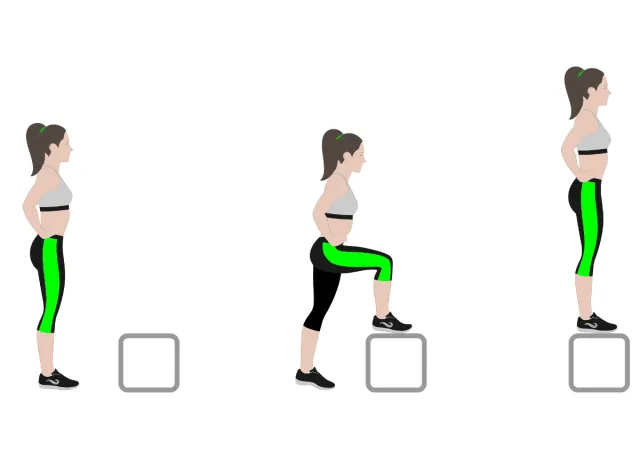
Box step-ups are fantastic for targeting your lower-body muscles, particularly your quadriceps. When incorporated into a superset, they add an element of cardiovascular challenge while promoting muscular endurance and strength. Additionally, the unilateral nature of step-ups helps to address any muscle imbalances and enhances overall functional fitness.
Start by standing before a sturdy box or bench with your feet hip-width apart. Step onto the box with your right foot, pressing through your right foot to push your body upward. Bring your left foot up to meet your right foot on top of the box, then lower yourself back down with control. Alternate legs for the desired number of repetitions, focusing on keeping your chest and core engaged throughout the movement. Adjust the box height to match your fitness level. Perform three to four sets of six to 12 repetitions per side with 90 seconds of rest between supersets.
3. Upper Push, Lower Pull Superset
An upper push, lower pull superset approach pairs exercises that focus on the chest and shoulders for the upper body with movements targeting the hamstrings and glutes (posterior chain) for the lower body. This strategy optimizes muscle engagement and time efficiency, as alternating between upper and lower-body exercises allows for more extended rest periods, enabling you to lift heavier weights for more repetitions.
Single-Arm Dumbbell Push Presses
The dumbbell push press is a dynamic exercise that enhances overall power while building strength and muscle mass in the shoulders and triceps. You engage your lower body to drive the dumbbell upward and finish the movement with a press, enabling a full-body training effect which is excellent for weight loss workouts. Opting for the single-arm variation boosts stability through increased muscle recruitment and addresses any existing asymmetries for a more balanced physique.
Hold a shoulder-high dumbbell in one hand with your elbow bent and palm facing inward. Stand with your feet shoulder-width apart, squeeze your core, and lower into a slight dip by bending your knees and hips. Explosively extend your legs and press the dumbbell overhead, using the momentum to assist the press. Then, lower the dumbbell back to the starting position under control. Complete three to four sets of six to 12 reps per side of the exercise, then transition directly into the single-leg dumbbell RDL set.
Single-Leg Dumbbell RDL
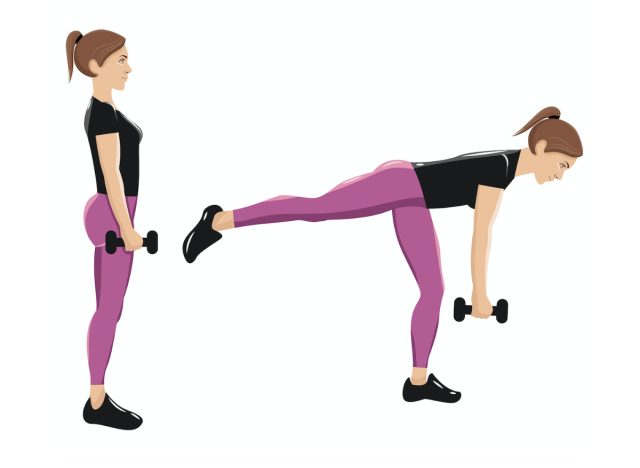
The single-leg dumbbell Romanian deadlift (RDL) is a top-tier exercise. It enhances balance and stability while isolating each leg (be ready for this challenge!), addressing muscle imbalances. Single-leg RDLs target key posterior chain muscles like the hamstrings, glutes, and lower back, developing strength and muscle development. Its unilateral nature improves functional strength and mobility, translating into better performance in everyday activities and sports.
Stand with your feet hip-width apart, holding a dumbbell in one hand. Shift your weight to one leg, maintaining a slight knee bend, and hinge forward at the hips, extending the opposite leg behind for balance. Lower the dumbbell toward the ground while keeping your back straight and hips level. Pause when parallel to the ground, then engage your hamstring and glute to return to the starting position. Complete three to four sets of six to 12 reps per side with 90 seconds of rest between supersets.
4. Lower Push, Upper Pull Superset
Combining lower-body push exercises with upper-body pull exercises in a superset is a strategic approach to strength training that maximizes efficiency and effectiveness. You optimize muscle recruitment and stimulate overall muscle growth by alternating between movements that target different muscle groups, such as squats or lunges for the lower body and rows or pull-ups for the upper body. This dynamic pairing saves time and enhances muscular balance and coordination, leading to strength gains throughout the body.
Back Squats
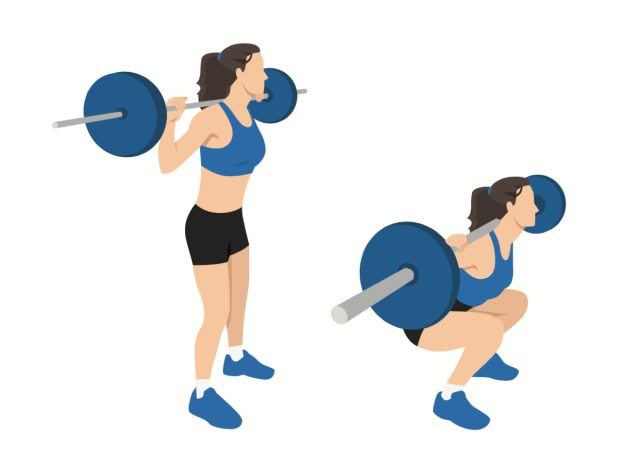
The back squat, hailed as the monarch of lower-body push exercises is pivotal for cultivating lower-body strength, size, and mobility. Engaging your quads and glutes fosters lean muscle development, translating to weight room prowess and functional strength in everyday activities.
Load your weight, and position your hands on a racked barbell just outside shoulder width. Step under the bar, squeeze your traps, and rest the barbell on your upper back. Once set, step back from the squat rack, firmly planting your feet hip-width apart. Brace your core, bend your knees, and descend into a squat, aiming for a 90-degree angle. Drive through your feet to stand back up. Repeat for the desired number of reps before safely reracking the barbell between sets. Perform three to four sets of eight to 12 repetitions of the exercise, then transition directly into the lat pulldown.
Feel free to substitute back squats with goblet squats, lunges, or step-ups if you lack equipment or space!
Lat Pulldowns
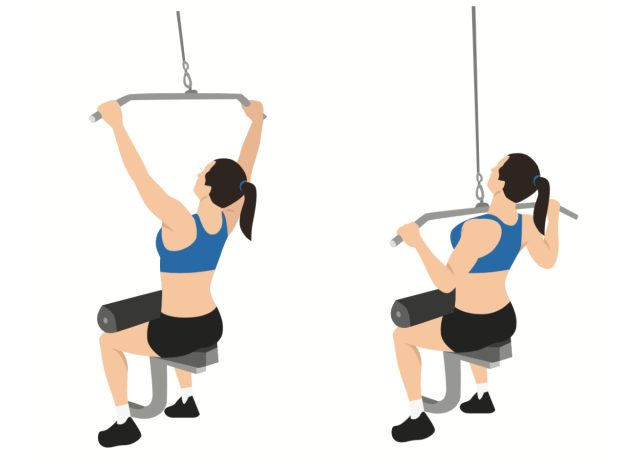
The lat pulldown reigns supreme for targeting the vertical muscle fibers of your upper and mid-back, allowing for higher volume compared to pull-ups or chin-ups. Pulldowns engage your lats, traps, and rhomboids, promoting upper-body strength and muscle development.
To perform the lat pulldown, grip the attachment with your preferred grip width, whether overhand, underhand, or mixed. Securely sit down, and place your knees underneath the pad, if available. Pull the bar down until it’s beneath your chin, maintain an upright posture with shoulders and chest up, and squeeze your lats. Slowly raise the bar back to the starting position, then repeat the movement for the desired number of repetitions. Perform three to four sets of 15 to 20 reps with 90 seconds of rest between supersets.
5. Full-body Superset
With this dynamic full-body superset, get ready to ignite your metabolism and elevate your heart rate and muscle engagement. Brace yourself because not only will your muscles feel the burn, but you’ll also experience a surge in metabolic activity.
One of my favorite combinations is the kettlebell thruster paired with a bent-over row during an RDL (Romanian deadlift). This duo isn’t just about hitting isolated muscles; it’s an approach that targets multiple muscle groups at once. Expect a potent impact on muscle growth, strength, and endurance, making every rep count towards your fitness goals.
In this workout, you’ll follow a superset interval format. Complete 10 to 14 rounds alternating between 30 seconds of exercise and 30 seconds of rest. Perform kettlebell thrusters during even-numbered rounds and dumbbell Romanian deadlifts with a row during odd-numbered rounds.
Kettlebell Thrusters
The kettlebell thruster is an ideal option for a superset due to its compound nature, engaging multiple muscle groups. Combining a squat and an overhead press into one fluid movement maximizes efficiency, intensity, and functional strength while providing cardiovascular benefits.
Grasp a kettlebell with an overhand grip at shoulder level (front rack position), positioning your feet shoulder-width apart. Descend into a squat while maintaining a straight back and an engaged core. As you rise from the squat, press the kettlebell overhead, extending your arms fully. Lower the kettlebell back to shoulder height as you descend into the next squat repetition. Ensure smooth, controlled transitions throughout.
Dumbbell RDLs to Rows
This dynamic duo will set your posterior chain on fire, targeting everything from your head to your hamstrings! The dumbbell Romanian deadlift to row seamlessly blends the lower-body focus of a Romanian deadlift, honing in on your hamstrings, glutes, and lower back, with the upper-body engagement of a bent-over row, amplifying strength and size gains in your lats, upper back, and core.
Hold dumbbells in front of your thighs with a neutral grip and your feet hip-width apart. Hinge at your hips, keeping your back flat and knees slightly bent, lowering the dumbbells toward the ground to feel a hamstring stretch. From the RDL position, pull the dumbbells up toward your chest by squeezing your shoulder blades and bending your elbows, performing a row. Extend your hips forward to return to the start position.







